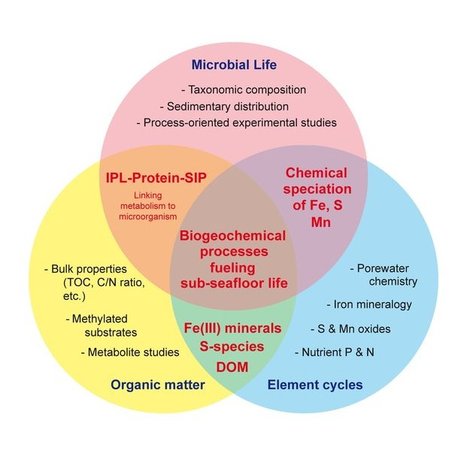Page path:
Project GB2
Biogeochemical processes fueling sub-seafloor life: transformations of C, S, and Fe
K.-U. Hinrichs, T. Ferdelman, M. Friedrich, V. Heuer, S. Kasten
M. Elvert, B. Koch, Y.-S. Lin, J.M. Mogollon, F. Schmidt, M. Zabel
M. Elvert, B. Koch, Y.-S. Lin, J.M. Mogollon, F. Schmidt, M. Zabel
Background
Sub-seafloor sediments harbor a substantial fraction of Earth’s biomass in the form of poorly explored microbial communities. These microbial communities mediate cycles of C, S, Fe, P, and N and influence the chemical speciation of these elements in the ocean. While microbial activity in shallow sediments is mainly controlled by the availability of organic matter and/or dissolved electron acceptors, other, so far unidentified factors appear to impact the activity of the sub-seafloor biosphere. This project seeks to better constrain key biogeochemical mechanisms in the sub-seafloor. To this end, we investigate how sub-seafloor microbes use particle-bound metal oxides for respiration. We want to find out if they can transform complex organic matter into low-molecular-weight compounds that serve as microbial substrates. And we are particularly interested in reactive sulfur species that might play a role for the deep biosphere due to the mechanisms by which they interact with Fe and organic matter.
Back to Geosphere-Biosphere Interactions

Research Questions
- Which processes and microorganisms drive the reduction of iron and manganese below the sulfate/methane transition zone (SMTZ)?
- To what extent are the reactions of sulfur intermediates with dissolved organic carbon and ferric iron-bearing minerals driven by microbes?
- What are the (precursor-product) relationships between the composition of dissolved organic matter (DOM), the formation of terminal substrates, and the biogeochemical regime?
- (How) do microorganisms mediate reactions of sulfur intermediates with DOM and ferric iron-bearing minerals and what are the consequences for the mobility of P and N?


